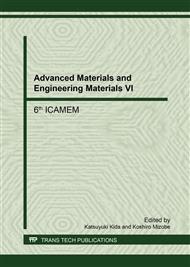p.35
p.39
p.45
p.51
p.55
p.62
p.69
p.74
p.79
A Comparison of the Polymer Matrix Behavior and Mechanical Properties of the Glass Reinforced Plastics and Glass Reinforced Epoxy Pipes under Different Oil Field Chemicals
Abstract:
Fiber reinforced composite material is used widely in oil fields for its high specific strength and resistance to corrosion. Glass reinforced plastics (GRP) and Glass reinforced epoxy (GRE) pipe samples were investigated under oil field conditions. The samples were subjected to ultraviolet radiation, moisture and elevated temperature using accelerating weathering machine and then aged in different environments encountered in oil well streams and characterized by using Scanning Electron Microscopy (SEM). The surface morphology was analyzed and the images produced from wet crude and effluent water has shown different degree of deformation of the glass fiber and debonding with the polymer matrix. The tensile and modulus properties were also evaluated and effect of ageing found to be more pronounced in the case of wet crude especially for the GRE. The study revealed some tendency of GRP samples to reform the polymer matrix interface with the glass fiber after weathering. The assessment of physical properties provided information about the structural stability of composite pipes under harsh environments, which in turn can impact their overall performance and service life.
Info:
Periodical:
Pages:
55-61
Citation:
Online since:
August 2017
Authors:
Keywords:
Price:
Сopyright:
© 2017 Trans Tech Publications Ltd. All Rights Reserved
Share:
Citation:


